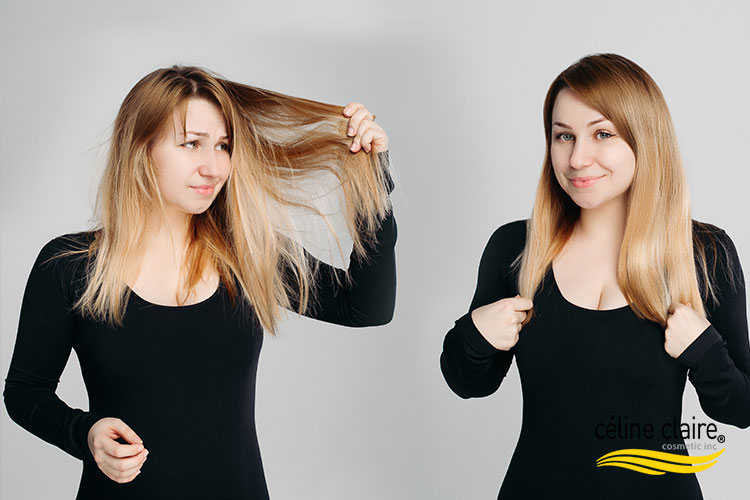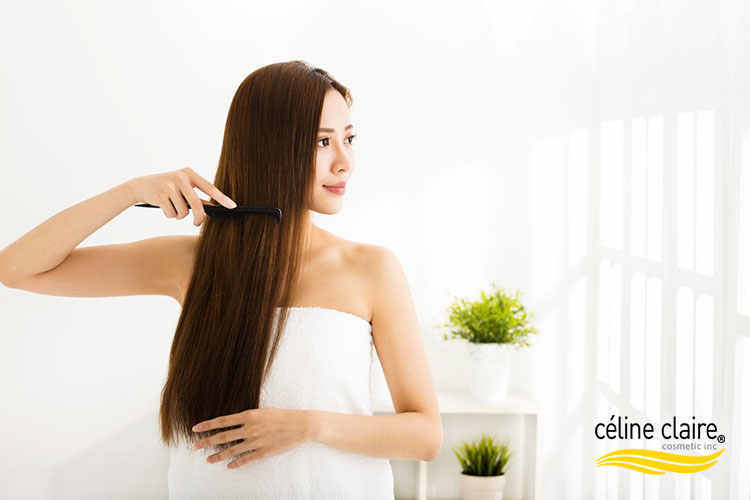
Hair Rebonding: Benefits and Side Effects
For many of us, taming frizzy, unruly hair can feel like an endless battle. This is where hair treatment options like hair rebonding step in.
For many of us, taming frizzy, unruly hair can feel like an endless battle. This is where hair treatment options like hair rebonding step in. Hair rebonding is a long-term solution for those of us who have naturally curly, wavy, or frizzy hair.
It gives you a straight shiny hair for months. But what is hair rebonding, and how does it compare to other repair products like keratin treatments? In this post, we’ll go over details of hair rebonding, its benefits, and whether it’s the right choice for you. Keep reading.
Hair rebonding can offer your hair an amazing change. However, understanding what happens during the treatment is important for finding out if it’s a good fit for you. Let’s see.
What is Hair Rebonding?
Hair is a tightly woven fabric with bonds which define its natural texture, be it curly, wavy, or straight. Hair rebonding is a chemical process that permanently changes these natural bonds, reconstructing them to make your hair straight and smooth. In short, it’s like resetting your hair’s “DNA” to keep it smooth and frizz-free.
The Rebonding Process
in professional hands, the rebonding process can take anywhere from 3 to 8 hours, depending on your hair type and length. You may have to be patient for a while, but the end product is well worth it. Here’s what typically happens:
Relaxant Application
A relaxant will be applied to the hair, breaking down your hair’s natural bonds. This phase is important to restructure the hair. Your stylist will closely monitor this stage to make sure that your hair is treated just enough to alter its bonds without causing serious harm.
Straightening
After the relaxant has been applied, the hair is completely washed and blown dry. The hairdresser next uses a flat iron to straighten the hair strand by strand. This is where rebonding happens, and heat seals the new structure.
Neutralizing Cream
A neutralizer will be applied to your hair to help seal in the new bonds and keep the straight shape. Following this step, your hair is permanently transformed into silky, straight strands.
Final Wash and Blow-Dry
The treatment will end with another wash and blow-dry, leaving you with beautifully straight hair that will last for months with proper care.
What is the Difference Between Hair Rebonding and Hair Keratin?
As you look up different hair treatment products choices, you may come across keratin treatments. Hair rebonding and keratin treatments both are intended to smooth and straighten the hair, but each takes a different technique.
Hair Rebonding
The treatment works by breaking and re-forming the hair bonds, resulting in permanently straightened hair. It is ideal for those seeking a big, long-term transformation.
Keratin Treatment
Unlike rebonding, keratin treatments aim to smooth and shine the hair rather than permanently altering its structure. Keratin, a natural protein in hair, is added to reduce frizz and give it a glossy finish. This treatment is more about improving your natural texture than changing it completely.
While both treatments are helpful, your choice depend on your hair goals. Rebonding is ideal for individuals seeking a permanent solution to handle resistant curls or waves, whilst keratin treatments are excellent for adding shine and minimizing frizz while keeping some natural texture.
Benefits of Hair Rebonding
Hair rebonding offers many benefits that can make your daily hair care routine easy:
Long-Lasting Straightness
Once done, hair rebonding gives you months of straight, smooth hair without the need for everyday straightening. It’s like having a ready-made, flawless hairstyle that looks great regardless of what the weather is.
Reduced Frizz
Rebonding reduces frizz and flyaways, making your hair easier to handle and giving it a sleeker appearance.
Shiny, Healthy-Looking Hair
The treatment adds a natural shine to your hair, giving it a glossy, healthy look.
Time Saving
With rebonded hair, you can cut down on your daily styling time. Instead of spending hours straightening your hair, it will be ready to go without any effort.
Easier Styling
Straight hair is generally easier to style and manage. With rebonding, you’ll find that creating different hairstyles is easier and more pleasant.
Complications of Hair Rebonding
While hair rebonding can be a wonderful change, it’s crucial to be informed of any issues and precautions.
Damage Hair
The chemical process of rebonding can lead to damage, especially if done incorrectly. Overuse of relaxants and heat might make your hair fragile.
Cost and Maintenance
Rebonding can be pricey, and you will need to touch up your hair on a regular basis to keep it looking fresh. Additionally, you might have to spend money in specific hair repair treatment products to keep your hair healthy.
Allergic Reactions
Some people might experience allergic reactions to the chemicals used in the process. Always perform a patch test before they start the hair treatment.
Hair Texture Changes
Rebonding may cause your hair to change texture or become less flexible. This could affect how well your hair keeps curls or volume.
Care After Hair Rebonding
Proper care is a must for maintaining the results of your rebonding treatment. Here’s how to keep your hair looking great:
Avoid Washing Immediately
After rebonding, avoid washing your hair for at least 48 to 72 hours to allow the treatment to fully set. This is like letting freshly painted walls dry completely before touching them.
Use Sulfate-Free Shampoos
use hair treatment products that are sulfate-free to avoid washing away essential moisture. These products are gentler on your hair and help keep the results of your treatment.
Condition Regularly
Use a deep conditioning treatment to keep your hair hydrated and to maintain the smooth texture and avoid any potential dryness from the chemical process.
Avoid Heat Styling
Minimize the use of heat styling tools, such as blow dryers and flat irons, as your hair is vulnerable to heat damage after rebonding. If you must use them, apply a heat protectant spray.
Protect from Sun and Chlorine
UV rays and chlorine from pools can damage your rebonded hair. Wear a hat or use UV-protective hair products when spending time in the sun or swimming.
Conclusion
Hair rebonding is a solution to those who want beautiful, manageable hair without the everyday effort. It combines the benefits of long-lasting straightness with less frizz and luster, making it a popular choice among many. However, understanding the potential problems and committing to proper care are necessary to fully enjoy the benefits of this hair repair treatment.
So, if you want to simplify your daily hair routine or achieve a perfected, professional look, hair rebonding might be an effective tool. But remember, choose the right stylist and have a thoughtful aftercare routine so you can enjoy the beautiful, straight hair you’ve always wanted.
FAQs
What is hair rebonding?
Hair rebonding is a chemical treatment that permanently straightens your hair by breaking and re-forming the bonds to achieve a smooth, straight look.
How does hair rebonding differ from hair keratin treatment?
Rebonding permanently straightens hair by modifying its bonds, while keratin treatments smooth and provide gloss without altering the natural structure.
What are the benefits of hair rebonding?
Benefits include long-lasting straightness, less frizz, shinier hair, and less daily styling time.
Are there any complications with hair rebonding?
Complications may include hair damage, high costs, allergic reactions, and changes in hair texture.
How should I care for my hair after rebonding?
Avoid washing for 48-72 hours, use sulfate-free shampoos, condition frequently, limit heat style, and protect from the sun and chlorine.
Can I wash my hair right after rebonding?
No, it is recommended to wait 48-72 hours for the therapy to fully set.
Is rebonding suitable for all hair types?
Rebonding works best on frizzy or wavy hair. Consult with a hairdresser to see if it is appropriate for your hair type.
How long does hair rebonding last?
The effects of hair rebonding usually last 6-12 months, depending on your hair growth and maintenance.
Can I use regular hair care products after rebonding?
Use sulfate-free hair treatment products to maintain the results and avoid stripping moisture from your hair.
Will rebonding make my hair completely straight?
Rebonding will straighten your hair, but the exact outcome will vary based on your hair’s natural texture and the treatment’s efficiency.





